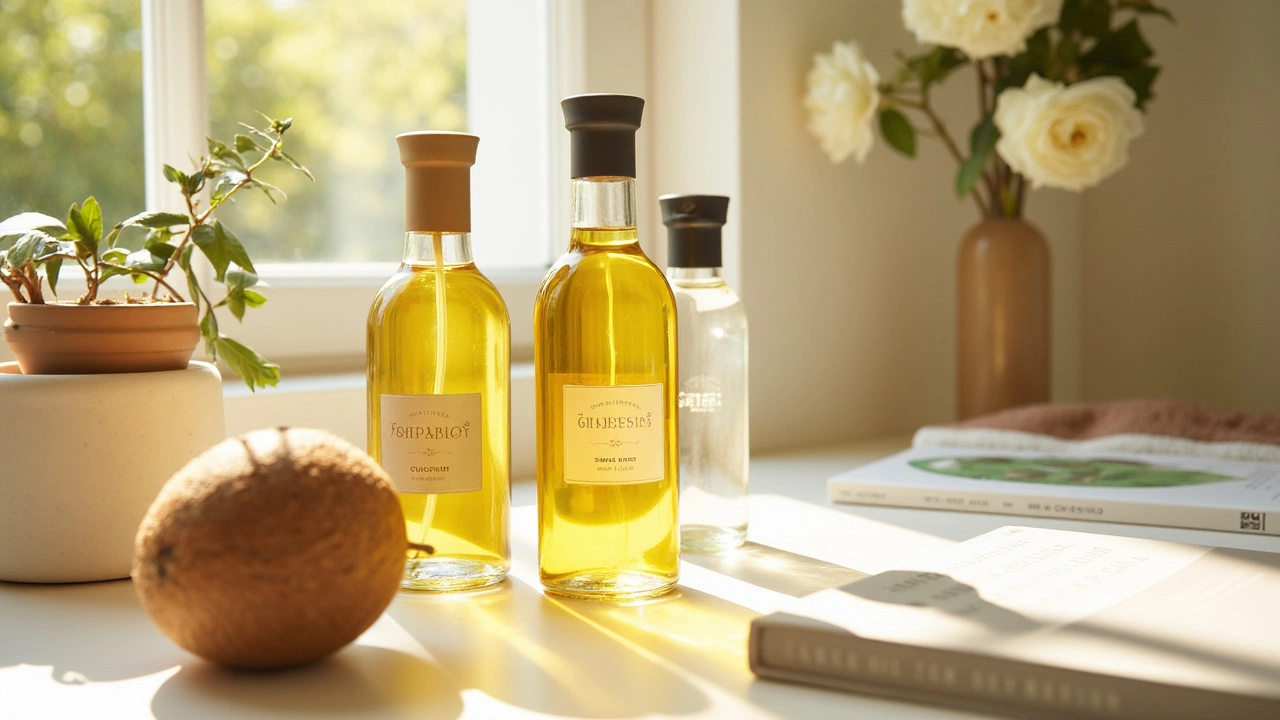Best Oils for a Relaxing Full Body Massage – Feel the Difference

Ever tried a massage that left your skin feeling greasy or sticky? The oil you pick makes a huge difference, not just in how your skin feels, but in how relaxed your whole body gets. Some oils just glide better, soak in faster, or smell so good that you instantly chill out. Others help soothe tired muscles or even add a bit of extra moisture to dry skin.
If you've only ever used whatever was lying around, you're definitely missing out. Sticking to common cooking oils can feel cheap, but their texture and scent sometimes just don’t cut it for real relaxation. For full body massages, certain oils take things to another level. They help your hands move with less friction, which means less dragging and more comfort. Plus, picking the right oil can even help with skin conditions like dryness or irritation.
Curious which options work best for a relaxing massage session at home or with a pro? There are so many choices—each with benefits and a few things to watch out for. Let's break it down and figure out what type of oil will turn your next massage from just okay to absolutely awesome.
- Why Oil Matters in a Full Body Massage
- Top Oils and Their Unique Benefits
- Choosing the Right Oil for Your Needs
- Tips for Massage Oil Safety and Storage
Why Oil Matters in a Full Body Massage
If you’ve ever had a full body massage with no oil or used the wrong kind, you know it’s just not the same. The right oil changes everything—it helps your hands or your massage therapist’s hands move across the skin smoothly, which means less pulling and less discomfort for you. Plus, the whole thing feels a lot more relaxing when there’s no annoying friction causing little tugs on your skin.
But it’s not just about comfort. Oils actually protect your skin during a massage. During a typical 60-minute full body session, you can lose moisture through your skin, especially if you have dry or sensitive skin by default. Massage oils lock in that moisture and keep your skin from getting irritated. A Canadian survey in 2023 found that 81% of massage therapists said the oil choice made a clear difference in client satisfaction, especially for folks with dry skin or minor rashes.
Scent matters too. Some oils come packed with natural smells that help you wind down—lavender or sweet almond oil, for example, can make a session feel like a spa day at home. The power of touch and scent work together, lowering heart rate and easing your mind at the same time.
- Better glide: Oils reduce friction, so the massage is smoother.
- Skin nourishment: Many massage oils are packed with vitamins like E and fatty acids that help heal and hydrate your skin.
- Stress relief: Essential oils (used carefully) can boost relaxation or even help with headaches.
- Customizable: You can switch up the oil for your needs—relaxation, pain relief, or even allergy-safe choices.
| Benefit | Impact |
|---|---|
| Friction Reduction | Less skin tugging, more comfort |
| Moisture Retention | Hydrated, soft skin after massage |
| Scent Benefits | Boosts mood and relaxation |
| Therapeutic Effect | Calms nerves, soothes muscles |
If you want your massage to hit maximum relaxation and have you waking up the next day with soft, happy skin, picking the right oil is the first step.
Top Oils and Their Unique Benefits
Not all oils are created equal when it comes to a full body massage. Each oil brings its own vibe—some sink in fast, some leave skin shiny, and some have that silky slip every massage needs. Here’s what matters most about the top picks, plus a handy comparison table with the facts you actually want.
- Sweet Almond Oil: This is a go-to for a reason. It’s light, not sticky, and doesn’t have a strong scent, so it won’t clash with any essential oils you add. It spreads easily and absorbs just fast enough, so you get that perfect glide without feeling too oily. It also packs vitamin E, making it great for skin health.
- Coconut Oil (Fractionated): Fractionated coconut oil stays liquid and clear, unlike regular coconut oil. It’s almost odorless, lightweight, and super easy on sensitive skin. Lots of people like that it doesn’t stain sheets or towels much—big plus if you’re doing massages at home.
- Jojoba Oil: Technically it’s a wax, but don’t let that throw you off. Jojoba mimics your skin’s natural oils, so it’s great for anyone with breakouts or eczema. It absorbs well and leaves skin soft, not greasy. Jojoba is also one of the most shelf-stable oils—won’t go rancid fast.
- Grapeseed Oil: This oil is super lightweight and almost completely scentless. It’s perfect if you want a thinner oil that doesn’t clog pores, and it’s loaded with antioxidants like vitamin E and linoleic acid.
- Olive Oil: You probably have this in your kitchen. It’s heavier and has a stronger scent, but it’s great at deeply moisturizing rough skin. Some people find it too thick for a full body massage, but it works wonders if your skin is really dry.
To make choices easier, check out the quick facts below:
| Oil | Main Benefits | Scent | Absorption Speed | Allergy Risks |
|---|---|---|---|---|
| Sweet Almond | Easy glide, vitamin E boost | Mild, nutty | Medium | Yes (nuts) |
| Coconut (Fractionated) | Non-staining, light, good for sensitive skin | Almost none | Medium-Fast | Rare |
| Jojoba | Balances skin, stable, non-greasy | Mild, almost none | Fast | Rare |
| Grapeseed | Light, non-clogging, antioxidant-rich | Neutral | Fast | Rare |
| Olive | Deeply moisturizing | Strong, grassy | Slow | Rare |
Don’t forget: Always check for nut allergies before using almond or similar oils. If you’re after a little aromatherapy, adding a few drops of essential oils like lavender or peppermint can really boost relaxation. Just make sure to patch test anything new on a small area first.

Choosing the Right Oil for Your Needs
This is where things get personal. Picking the best oil for your full body massage depends on what you want—something smooth, an oil that smells great, or one that takes care of sensitive skin. Some folks want a 100% natural oil, while others just want the lightest option with zero strong scent. Here’s what you should think about before grabbing a bottle.
- Skin Type: If your skin acts up with rashes or breakouts, go unscented and hypoallergenic. Sweet almond oil is usually safe for most, but coconut oil is a good backup for people with nut allergies.
- Allergies: If you or your massage partner have allergies to nuts, stick with oils like grapeseed, sunflower, or fractionated coconut. Always double-check the label for any hidden extras.
- Absorption Rate: Want quick absorption so you’re not slick after the massage? Grapeseed and apricot kernel oils absorb fast. Olive and coconut leave more of a residue—better for super dry skin but a hassle if you want to dress quickly.
- Scent: Some oils have a neutral smell, while others are nutty or sweet. Jojoba’s super mild, while coconut has a vacation vibe. If you want your massage to double as aromatherapy, pick oils that blend well with essential oils, like sunflower or apricot kernel.
Check out this quick cheat sheet to get a feel for what each oil does best.
| Oil | Best For | Absorption | Scent |
|---|---|---|---|
| Sweet Almond | Most skin types | Medium | Nuts, light |
| Coconut (Fractionated) | Sensitive, allergy-prone skin | Fast | Slightly sweet |
| Jojoba | Oily, acne-prone skin | Fast | Very mild |
| Olive | Extra dry skin | Slow | Distinct, earthy |
| Grapeseed | Light feel, quick absorption | Fast | Barely any |
One last tip: If you're mixing in essential oils, keep the ratio safe—just a few drops per tablespoon of carrier oil is plenty. Always do a skin patch test first if you’re trying something new. That way, you skip the drama of a skin reaction and just get the good stuff: a massage that feels amazing.
Tips for Massage Oil Safety and Storage
It’s way too easy to overlook how you handle and keep your oils, but safety and storage make a real difference in both your massage experience and your skin’s health. Some oils go bad fast or can irritate your skin if you aren’t careful, so it pays to know the basics.
Full body massage sessions can quickly go south if you’re using oil that’s turned rancid or has picked up bacteria. Here are a few key things to keep in mind to make sure your oils stay fresh and safe every time:
- Check Expiry Dates: Oils can and do go bad. Most have a shelf life of 6 months to a year. Jojoba and coconut oil last longer, but grapeseed and sweet almond will turn faster. Always smell before you use—any sour or musty scent is a red flag.
- Keep It Cool and Dark: Sunlight and heat speed up how fast oils break down. Store them in a dark cupboard away from the window or heating vents. Glass bottles (especially dark ones) help too.
- Wash Your Hands First: Dipping dirty hands into your oil can introduce bacteria and mess up the whole bottle. If you can, pour out the oil instead of dipping.
- Avoid Direct Skin Contact with Bottles: Don’t let the bottle opening touch skin repeatedly, especially if you’re working with multiple people, to avoid cross-contamination.
- Label and Date Bottles: Write the date you first opened or made a blend. Some people even keep a Sharpie and masking tape handy for this.
- Patch Test New Oils: Especially if you’ve never used a certain oil before, rub a bit on your inside wrist and wait 24 hours. No reaction? You’re probably good.
"We always recommend checking all carrier oils for odor and clarity once a month—especially if they’re being used in a professional practice." — The National Association for Holistic Aromatherapy (NAHA)
If you mix oils with essential oils for scent, use less than 2% essential oil to carrier oil to keep things safe for skin. That’s about 12 drops essential oil per one ounce carrier oil.
If you’re ever in doubt about an oil’s safety or freshness, toss it. Seriously, bad oil can cause breakouts or skin irritation.
| Oil | Typical Shelf Life (Unopened/Stored Well) | Notes |
|---|---|---|
| Jojoba | 12-24 months | Longest-lasting; almost never goes rancid |
| Sweet Almond | 6-12 months | Can spoil quickly if left in heat |
| Grapeseed | 6 months | Keep refrigerated for best shelf life |
| Coconut (fractionated) | 18-24 months | Resistant to rancidity, no refrigeration needed |
Stick to these quick habits, and you’ll get the most out of your massage oils—no more wasted money or annoying skin troubles.



